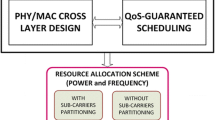Abstract
In UMTS technology, Coded Composite Transport Channels (CCTrCh-s) are used to carry multiple Transport Channels (TrCh-s) in parallel on (usually) one physical layer connection. Rate Matching Attributes (RMA-s) are used to share the CCTrCh resources among the transport channels. We consider I transport channels on the downlink of a UMTS network, with RMA values RMA 1,RMA 2,…,RMA I . The QoS experienced by the multiplexed connections depends on the RMA values used. We derive analytical expressions for the Bit Error Probabilities (BER-s) seen by each uncoded TrCh in the multiplex when transmitted over an AWGN and a multipath channel. Simulations indicate that the expressions are very accurate. Next, we derive analytical expressions for bounds on the per-channel bit error probabilities seen when convolutional coding is employed by each channel and the multiplex is transmitted over an AWGN and a multipath channel, respectively. The derivation of these analytical expressions is the main contribution of this paper. Further, we use the expressions to obtain simple procedures that provide the RMA values required to achieve a target set of BER-s for a specified signal-to-noise ratio. The results of this paper indicate how differentiated QoS may be provided while maintaining high spectral efficiency.
Similar content being viewed by others
References
E. Dahlman, B. Gudmundson, M. Nilsson and J. Skold, UMTS/IMT-2000 Based on WCDMA, IEEE Communications Magazine 36(8) (September 1998) pp. 1094–1105.
I. Sohn and S.C. Bang, Performance studies of rate matching for WCDMA mobile receiver, IEEE VTC 2000 Vol. 6 (September 2000) pp. 2661–2665.
P.B. Nath, P. Padmagowri, S.S. Kumar, S. Shankar, B. Jayachandran, B. V. Rao and F. David, Selection of rate matching attributes for the 3GPP multiplexing and channel coding chain, SPCOM 2001: 6th Biennial Conference Proceedings (July 15–18 2001) pp. 140–145.
S. Baey, M. Dumas and M.-C. Dumas, QoS tuning and resource sharing for UMTS WCDMA multiservice mobile, IEEE Transactions on Mobile Computing 1(3)(July-September 2002) pp. 221–235.
S. Aftelak and D. Bhatoolaul, Rate matching attribute settings and error performance for selected umts fdd services, in: Proceedings of the IEEE Vehicular Technology Conference, Fall 2003, pp. 1558–1562.
J. Hagenauer, Rate compatible punctured convolutional codes and their applications, IEEE Transactions on Communications, 36(4) (April 1988) pp. 389–400.
A.J. Viterbi, Convolutional codes and their performance in communication systems, IEEE Transactions on Communications Technology COM-19(5) (October 1971) pp. 751–772.
3GPP TS 25.212 V5.0.0, Technical Specification, Multiplexing and Channel Coding (FDD).
B. Sklar, Digital communications, fundamentals and applications, 2nd edition, Pearson Education, Asia}.
J.G. Proakis, Digital communications, 3nd edition, McGRaw-Hill International Editions}.
P. Schramm, Tight upper bound on the bit error probability of convolutionally encoded spread spectrum communication over frequency-selective Rayleigh fading, IEEE International Conference on Communications 3(18–22) (June 1995) pp. 1727–1731.
J.M. Wozencraft and I.M. Jacobs, Principles of communication engineering, John Wiley & Sons, New York, 1965.
J. Conan, The weight spectra of some short low-rate convolutional codes, IEEE Transactions on Communications COM-32(9) (September 1984) pp. 1050–1053.
User guide for RadioLab 3G, www.radioscape.com.
Author information
Authors and Affiliations
Corresponding author
Additional information
R. M. Karthik is currently a Ph.D. candidate in the Centre for Electronics Design and Technology, Indian Institute of Science, Bangalore, India. He received his B. E. (Electronics and Communication Engineering) from Government College of Technology, Coimbatore, India in 1998 and M. E. (Applied Electronics) from College of Engineering, Guindy, Anna University, India in 2000. His current research interests include communication networks and QoS in UMTS Networks.
Joy Kuri has a B.E. in Electronics and Telecommunication engineering from Jadavpur University, Kolkata. After a year in the industry, he joined the M.E. program in the Department of Electrical Communication Engineering at the Indian Institute of Science. He went on to receive a Ph.D. from the same department at IISc in 1995. Subsequently, he spent two years at Ecole Polytechnique, University of Montreal, Canada and one and a half years in INRS-Telecommunications, University of Quebec, Canada as a Research Associate. Since 1999 he has been with the Centre for Electronics Design and Technology, Indian Institute of Science, where he is currently Associate Professor. His research and teaching interests are in the areas of modelling, analysis and control of communication networks and stochastic systems. He is co-author of the book Communication Networking: An Analytical Approach by Kumar, Manjunath and Kuri, published by Morgan Kaufman/Elsevier.
Rights and permissions
About this article
Cite this article
Kuri, J., Karthik, R.M. BER evaluation and rate matching attribute selection for QoS support on the UMTS downlink. Wireless Netw 14, 877–894 (2008). https://doi.org/10.1007/s11276-007-0030-0
Published:
Issue Date:
DOI: https://doi.org/10.1007/s11276-007-0030-0




